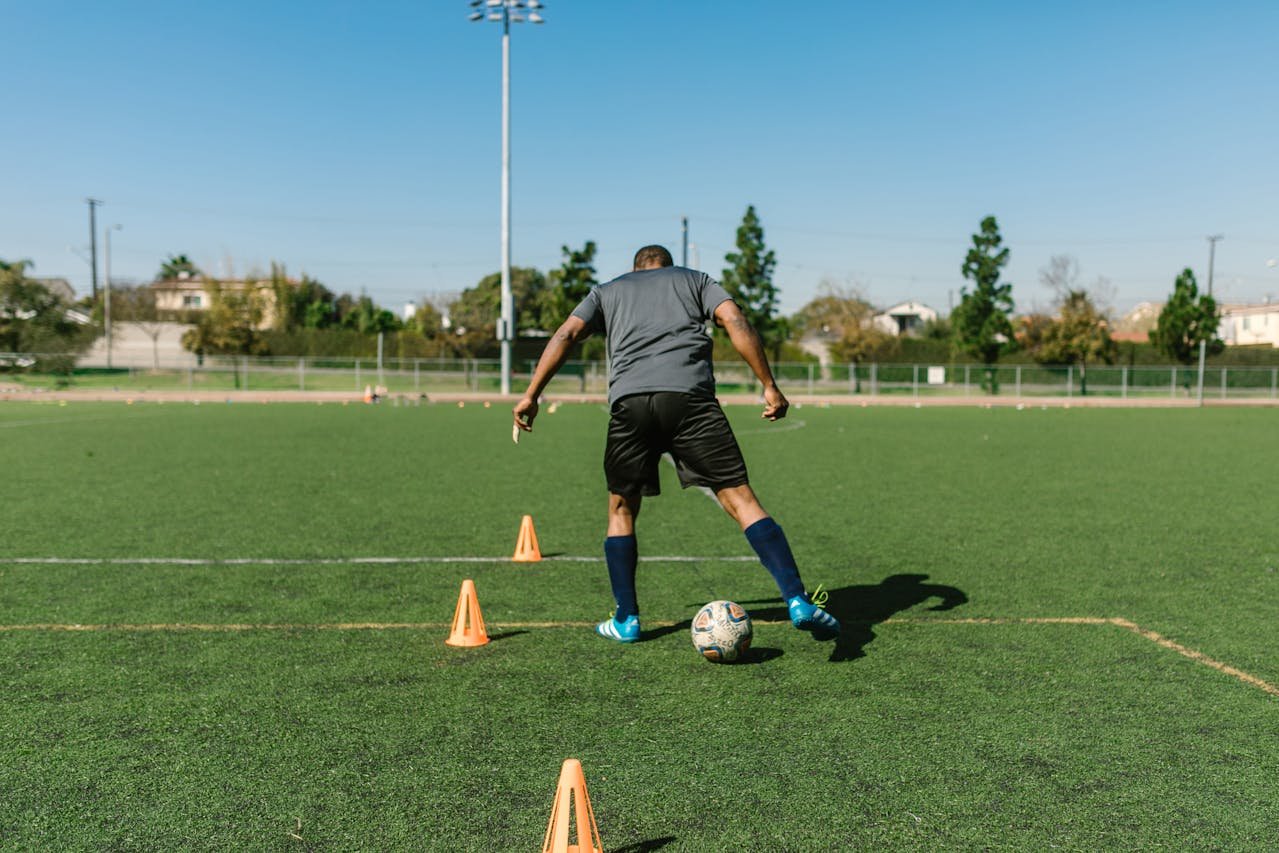Soccer is a game of precision, control, and agility. If you’re looking to up your game, you don’t need to wait for practice with your team to improve. The beauty of soccer is that you can train on your own at home, anytime you want. But how can you make the most of your solo sessions? The answer lies in focusing on the right drills.
In this article, we’ll explore the top 5 solo soccer drills to practice at home. Whether you’re a beginner or an experienced player, these exercises will help you sharpen your skills and take your game to the next level. You don’t need a fancy field or a team to get better at soccer—just a ball, a little space, and some dedication. Ready to take your skills up a notch? Let’s dive in.
Why Practice Solo Soccer Drills?
Many players overlook the importance of practicing on their own. While team practice is essential for learning tactical plays and improving communication, solo practice offers benefits that can’t be overlooked. Here’s why solo drills should be part of your routine:
- Improved Technical Skills: Practicing by yourself allows you to focus on ball control, dribbling, and passing without distractions.
- Personalized Progress: You can tailor your practice sessions to target areas where you need improvement, whether it’s your weak foot or your first touch.
- Flexibility: With solo drills, you can practice whenever it’s convenient for you, regardless of team schedules.
- Build Confidence: Repeating drills on your own builds muscle memory and boosts your self-assurance on the field.
Incorporating solo drills into your routine will allow you to consistently improve and develop a deeper understanding of the game, even when you don’t have a partner or team to practice with.
1. Juggling for Ball Control
One of the most foundational skills in soccer is ball control. The more you can control the ball, the better your chances of keeping possession in tight situations during a game. Juggling is a fantastic way to improve your ball control and touch. Not only does it help with maintaining possession, but it also enhances your coordination, balance, and concentration.
How to Do It:
- Start by using your dominant foot to kick the ball up into the air.
- Let the ball fall, and when it starts coming down, use your foot to tap the ball gently, keeping it in the air.
- Try to juggle the ball with both feet, alternating between each foot as you get more comfortable.
- If you’re feeling confident, you can try juggling with your thighs or head for added difficulty.
Helpful Hint:
If you’re struggling to keep the ball in the air, start by using just one foot and focus on tapping the ball gently, not kicking it too hard. Start slow and gradually build your rhythm. Consistency is key to improving.
Why It’s Beneficial:
Juggling helps improve touch, balance, and coordination, which are essential skills for controlling the ball under pressure in a game. It also builds confidence in your ability to manipulate the ball, whether you’re trapping, passing, or shooting. Start with a few minutes of juggling each day and increase your time as you improve.
Stats:
Studies show that players who juggle for at least 10 minutes a day can see significant improvements in their first touch and ball control. A consistent juggling routine can increase a player’s ball control by up to 25% in just a few weeks. (Source: Soccer Training Expert)
2. Cone Drills for Dribbling and Agility
Dribbling is a critical skill that all soccer players need to master. It allows you to move the ball around opponents, maintain possession, and create goal-scoring opportunities. A great way to practice dribbling on your own is by setting up cone drills.
How to Set Up the Drill:
- Place 5-10 cones in a line, about 2-3 feet apart, on a flat surface.
- Start by dribbling the ball around the cones, making sharp turns and quick touches to avoid the cones.
- Focus on keeping the ball close to your feet while maintaining control at all times.
- After completing one round, challenge yourself by increasing your speed or using both feet to dribble the ball around the cones.
Helpful Hint:
Start slowly to get a feel for controlling the ball as you maneuver around the cones. Once you’re comfortable, try to increase your speed without sacrificing ball control. Keep your head up and use your peripheral vision to spot the cones while maintaining your dribbling technique.
Why It’s Beneficial:
Cone drills help improve your dribbling technique by forcing you to make sharp turns and control the ball in tight spaces. This is crucial for avoiding defenders in game situations. Additionally, it boosts your agility and reaction time, which are essential for both attacking and defending.
3. Passing Against a Wall for Accuracy
Passing is an essential part of soccer, whether you’re setting up a play or maintaining possession. Practicing your passing accuracy on your own is possible with a simple wall. This solo drill is great for improving both short and long passing.
How to Do It:
- Find a solid wall with enough space to pass the ball back and forth.
- Start by passing the ball to the wall using your dominant foot.
- As the ball rebounds, control it and pass it back with the same foot.
- Gradually increase the difficulty by using your weaker foot, and focus on accuracy and precision.
Why It’s Beneficial:
Practicing passing against a wall helps improve your touch, control, and passing technique. You can also challenge yourself to focus on one-touch passes and work on your weak foot. This drill simulates a game scenario where you need to pass the ball under pressure.
Helpful Hint:
To enhance this drill, vary your distance from the wall. Start at a short distance and then move farther back to practice longer passes. This will help simulate game conditions where you need to pass at various ranges.
4. Shooting Drills for Precision and Power
One of the most exciting and rewarding aspects of soccer is scoring goals. But to become a goal-scoring machine, you need to practice shooting with precision and power. A simple target shooting drill can be done right at home, whether you’re in your backyard or on an open space.
How to Do It:
- Set up a target area—this could be cones, a small net, or simply marked areas on a wall where you want to aim.
- Take a shot at the target from various distances. Focus on hitting specific spots rather than just kicking the ball as hard as possible.
- After each shot, evaluate your form and adjust your aim accordingly.
- Mix it up with both feet to increase your versatility and control.
Why It’s Beneficial:
Shooting drills help improve both the accuracy and power of your shots. By setting a target, you force yourself to aim precisely, which translates to better decision-making and shot selection in a real game.
Stats:
Players who practice target shooting regularly can see improvements in their shot accuracy by as much as 20%. (Source: Soccer Training Resources)
5. Sprint Drills for Speed and Endurance
Speed is a game-changer in soccer. Whether you’re chasing the ball or sprinting to make a break, your speed can make all the difference. Sprint drills are a great way to enhance your sprinting power and endurance.
How to Do It:
- Find a flat surface or a space that allows you to sprint back and forth.
- Mark a starting point and sprint to a designated spot (e.g., 20 meters away), then jog back to recover.
- Repeat the sprint-jog cycle for several rounds. Focus on explosive starts and controlled recovery.
- Increase the number of sprints or reduce your recovery time as your endurance improves.
Why It’s Beneficial:
Sprint drills improve your speed, acceleration, and overall fitness. Soccer requires bursts of speed, so training your body to handle quick sprints followed by short recovery periods will prepare you for the demands of the game.
Helpful Hint:
Incorporate interval training by varying your sprinting distances and recovery times. For example, try sprinting 10 meters at full speed, followed by 20 seconds of walking or jogging. Gradually increase the sprinting distance as you improve.
Frequently Asked Questions
Wrapping Up
Solo soccer drills are an excellent way to improve your skills and stay fit without needing a team or a full field. By practicing key drills like juggling, dribbling, passing, shooting, and sprinting, you can enhance your ball control, agility, accuracy, and speed, all from the comfort of your home. The key is consistency, so make these drills part of your regular practice routine.
No matter your skill level, these drills can help you develop important soccer abilities that will elevate your game. As you continue practicing, track your progress and challenge yourself to reach new milestones. Keep pushing your limits and you’ll see great results on the field.





